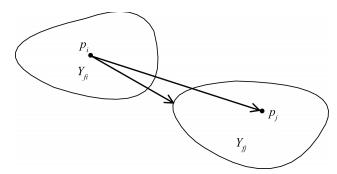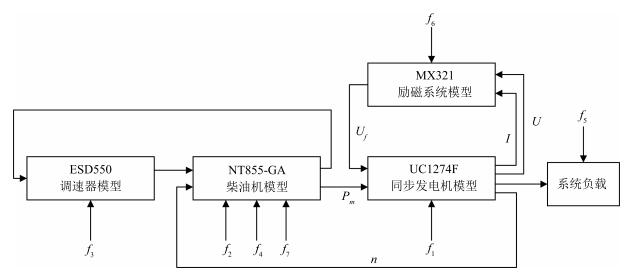Research on Sensor Optimal Placement Method Using Quantitative Evaluation of Fault Diagnosability
-
摘要: 提出了一种基于故障可诊断性量化评价的传感器优化配置方法.针对可能发生故障的非线性系统,首先,基于K-L散度思想,通过计算故障情形下残差概率密度函数的差异度,得到了系统不同故障下故障可检测性和可分离性的量化指标,由于稀疏内核密度估计和蒙特卡洛算法的引入,克服了K-L散度计算中残差概率密度函数难以估计和非线性结构的K-L散度计算复杂度高的困难;其次,以故障可诊断性的定量评价为基础,借助于动态规划方法给出了系统满足期望故障可诊断性的传感器最优集合;最后,通过数值仿真和实体实验仿真验证了文中方法在故障诊断系统传感器优化配置中的有效性.Abstract: A method of sensor optimal placement using quantitative evaluation of fault diagnosability is proposed. With the idea of K-L divergence, using quantificational indices of fault detectability and isolability under different fault conditions are obtained by calculating the difference degree of residual probability density function. Sparse kernel density estimation and Monte Carlo algorithm are introduced to overcome the difficulty of estimating the residual probability density function of K-L divergence calculation and high complexity of K-L divergence computation of nonlinear structure. Secondly, with the quantitative evaluation of fault diagnosability, the optimal set of sensors satisfying the expected fault diagnosability is given by means of dynamic programming method. Finally, the validity of the proposed method is validated through numerical simulation and physical experiment simulation in a sensor optimal configuration of fault diagnosis system.
-
-
表 1 故障可诊断性分析
Table 1 Fault diagnosability analysis
FD $f_{1}$ $f_{2}$ $f_{3}$ $f_{4}$ $f_{1}$ $\times$ 0 0 $\times$ $\times$ $f_{2}$ $\times$ 0 0 $\times$ $\times$ $f_{3}$ $\times$ $\times$ $\times$ 0 $\times$ $f_{4}$ $\times$ $\times$ $\times$ $\times$ 0 表 2 故障可诊断性量化评价
Table 2 Quantitative evaluation of fault diagnosability
$\{x_1, x_3\}$ FD $f_{1}$ $f_{2}$ $f_{3}$ $f_{4}$ $f_{1}$ 0.036 0 0 0.058 0.061 $f_{2}$ 0.054 0 0 0.099 0.054 $f_{3}$ 0.008 0.051 0.074 0 0.116 $f_{4}$ 0.093 0.059 0.053 0.129 0 表 3 故障可诊断性量化评价
Table 3 Quantitative evaluation of fault diagnosability
$\{x_{2}, x_{4} \}$ FD $f_{1}$ $f_{2}$ $f_{3}$ $f_{4}$ $f_{1}$ 0.055 0 0 0.089 0.083 $f_{2}$ 0.086 0 0 0.098 0.063 $f_{3}$ 0.122 0.133 0.126 0 0.285 $f_{4}$ 0.232 0.080 0.059 0.180 0 表 4 非线性系统故障可诊断性量化评价
Table 4 Quantitative evaluation of fault diagnosability for nonlinear systems
FD $f_{1}$ $f_{2}$ $f_{3}$ $f_{4}$ $f_{1}$ 0.660 0 0 1.412 1.564 $f_{2}$ 0.671 0 0 1.273 2.229 $f_{3}$ 1.532 1.518 1.936 0 0.330 $f_{4}$ 1.510 1.617 2.520 0.202 0 表 5 非线性系统故障可诊断性量化评价
Table 5 Quantitative evaluation of fault diagnosability for nonlinear systems
{$x_{2}$, $x_{3}$, $x_{4}$} FD $f_{1}$ $f_{2}$ $f_{3}$ $f_{4}$ $f_{1}$ 0.460 0 0 1.142 0.465 $f_{2}$ 0.423 0 0 1.103 1.110 $f_{3}$ 1.067 1.174 1.248 0 0.143 $f_{4}$ 1.028 0.379 1.039 0.156 0 表 6 车辆电源常见故障描述
Table 6 Common fault description of vehicle power supply
故障 故障描述 $f_{1}$ 发电机失磁 $f_{2}$ 柴油滤清器堵塞 $f_{3}$ 调速器调节失灵 $f_{4}$ 发动机高温 $f_{5}$ 系统超载 $f_{6}$ 励磁模块故障 $f_{7}$ 喷油嘴故障 表 7 故障可诊断性定性评价
Table 7 Qualitative evaluation of fault diagnosability
$r_{1}$ $r_{2}$ $r_{3}$ $r_{4}$ $r_{5}$ $r_{6}$ $r_{7 }$ $f_{1}$ 0 0 0 1 0 1 0 $f_{2}$ 0 0 0 0 0 1 0 $f_{3}$ 1 0 0 0 1 0 1 $f_{4}$ 0 0 1 0 0 1 0 $f_{5}$ 0 1 1 0 0 0 0 $f_{6}$ 1 1 0 0 0 1 0 $f_{7}$ 0 0 0 0 0 1 0 表 8 故障可诊断性量化评价
Table 8 Quantitative evaluation of fault diagnosability
FD $f_{1}$ $f_{2}$ $f_{3}$ $f_{4}$ $f_{5}$ $f_{6}$ $f_{7 }$ $f_{1}$ 0.3462 0 0.1298 0.8978 0.1290 0.1432 0.2765 0.0988 $f_{2}$ 0.4387 0.1304 0 0.8070 0.9908 0.1435 0.2787 0 $f_{3}$ 0.2122 0.9029 0.7865 0 0.7434 0.4634 0.4172 0.8432 $f_{4}$ 0.3456 0.1300 0.8990 0.7321 0 0.6432 0.7432 0.8432 $f_{5}$ 0.6783 0.1765 0.1543 0.4764 0.7325 0 0.3434 0.1088 $f_{6}$ 0.5435 0.2910 0.2898 0.4278 0.7000 0.3299 0 0.5898 $f_{7}$ 0.7646 0.0910 0 0.1022 0.7853 0.0987 0.5786 0 -
[1] 周东华, 刘洋, 何潇.闭环系统故障诊断技术综述.自动化学报, 2013, 39(11):1933-1943 http://www.aas.net.cn/CN/Y2013/V39/I11/1933Zhou Dong-Hua, Liu Yang, He Xiao. Review on fault diagnosis techniques for closed-loop systems. Acta Automatica Sinica, 2013, 39(11):1933-1943 http://www.aas.net.cn/CN/Y2013/V39/I11/1933 [2] Zhang K K, Jiang B, Yan X G, Mao Z H. Sliding mode observer based incipient sensor fault detection with application to high-speed railway traction device. ISA Transactions, 2016, 63:49-59 doi: 10.1016/j.isatra.2016.04.004 [3] Lan J L, Patton R J. A new strategy for integration of fault estimation within fault-tolerant control. Automatica, 2016, 69:48-59 doi: 10.1016/j.automatica.2016.02.014 [4] Gao Z W, Cecati C, Ding S X. A survey of fault diagnosis and fault-tolerant techniques-part 1:fault diagnosis with model-based and signal-based approaches. IEEE Transactions on Industrial Electronics, 2015, 62(6):3757-3767 doi: 10.1109/TIE.2015.2417501 [5] Li J, Yang G H. Simultaneous fault detection and control for switched systems with actuator faults. International Journal of Systems Science, 2016, 47(10):2411-2427 doi: 10.1080/00207721.2014.998740 [6] Debouk R, Lafortune S, Teneketzis D. On an optimization problem in sensor selection. Discrete Event Dynamic Systems, 2002, 12(4):417-445 doi: 10.1023/A:1019770124060 [7] Rosich A, Yassine A A, Ploix S. Efficient optimal sensor placement for structural model based diagnosis. In: Proceedings of the 21st International Workshop on Principles of Diagnosis. Portland, Oregon, USA: DX'10, 2010. 135-142 [8] Frisk E, Krysander M, Åslund J. Sensor placement for fault isolation in linear differential-algebraic systems. Automatica, 2009, 45(2):364-371 doi: 10.1016/j.automatica.2008.08.013 [9] Eguchi S, Copas J. Interpreting Kullback-Leibler divergence with the Neyman-Pearson lemma. Journal of Multivariate Analysis, 2006, 97(9):2034-2040 doi: 10.1016/j.jmva.2006.03.007 [10] Eriksson D, Frisk E, Krysander M. A method for quantitative fault diagnosability analysis of stochastic linear descriptor models. Automatica, 2013, 49(6):1591-1600 doi: 10.1016/j.automatica.2013.02.045 [11] 李文博, 王大轶, 刘成瑞.动态系统实际故障可诊断性的量化评价研究.自动化学报, 2015, 41(3):497-507 doi: 10.16383/j.aas.2015.c140428Li Wen-Bo, Wang Da-Yi, Liu Cheng-Rui. Quantitative evaluation of actual fault diagnosability for dynamic systems. Acta Automatica Sinica, 2015, 41(3):497-507 doi: 10.16383/j.aas.2015.c140428 [12] Harmouche J, Delpha C, Diallo D. Incipient fault amplitude estimation using KL divergence with a probabilistic approach. Signal Processing, 2016, 120:1-7 doi: 10.1016/j.sigpro.2015.08.008 [13] Youssef A, Delpha C, Diallo D. An optimal fault detection threshold for early detection using Kullback-Leibler divergence for unknown distribution data. Signal Processing, 2016, 120:266-279 doi: 10.1016/j.sigpro.2015.09.008 [14] Eriksson D, Krysander M, Frisk E. Using quantitative diagnosability analysis for optimal sensor placement. IFAC Proceedings Volumes, 2012, 45(20):940-945 doi: 10.3182/20120829-3-MX-2028.00196 [15] Krysander M, Frisk E. Sensor placement for fault diagnosis. IEEE Transactions on Systems, Man, and Cybernetics——Part A:Systems and Humans, 2008, 38(6):1398-1410 doi: 10.1109/TSMCA.2008.2003968 [16] Eriksson D, Krysander M, Frisk E. Quantitative fault diagnosability performance of linear dynamic descriptor models. In: Proceedings of the 22nd International Workshop on Principles of Diagnosis. Murnau, Germany, 2011. 1-8 [17] Eriksson D, Krysander M, Frisk E. Quantitative stochastic fault diagnosability analysis. In: Proceedings of the 50th IEEE Conference on Decision and Control and European Control Conference (CDC-ECC). Orlando, Florida, USA: IEEE, 2011. 1563-1569 [18] Hong X, Chen S, Becerra V M. Sparse density estimator with tunable kernels. Neurocomputing, 2016, 173:1976-1982 doi: 10.1016/j.neucom.2015.08.021 [19] Doucet A, Godsill S, Andrieu C. On sequential Monte Carlo sampling methods for Bayesian filtering. Statistics and Computing, 2000, 10(3):197-208 doi: 10.1023/A:1008935410038 [20] Alban A, Darji H A, Imamura A, Nakayama M K. Efficient Monte Carlo methods for estimating failure probabilities. Reliability Engineering and System Safety, 2017, 165:376-394 doi: 10.1016/j.ress.2017.04.001 [21] 张化光, 张欣, 罗艳红, 杨珺.自适应动态规划综述.自动化学报, 2013, 39(4):303-311 http://www.aas.net.cn/CN/abstract/abstract17916.shtmlZhang Hua-Guang, Zhang Xin, Luo Yan-Hong, Yang Jun. An overview of research on adaptive dynamic programming. Acta Automatica Sinica, 2013, 39(4):303-311 http://www.aas.net.cn/CN/abstract/abstract17916.shtml [22] Cai Y Z, Ji R R, Li S Z. Dynamic programming based optimized product quantization for approximate nearest neighbor search. Neurocomputing, 2016, 217:110-118 doi: 10.1016/j.neucom.2016.01.112 期刊类型引用(23)
1. 周耀威,孔令军,戴琪,郭乐婷,张楠,蒋阮昕明,叶全意,赵宁,金秀峰. 基于多头自注意力机制的轻量级包裹破损检测算法. 无线电通信技术. 2025(01): 161-170 .  百度学术
百度学术2. 熊天赐,何乐阳,朱洪浩,侯勇. 基于改进YOLOv8算法的西红柿自动采摘识别系统. 数字农业与智能农机. 2025(02): 26-31 .  百度学术
百度学术3. 林宗缪,马超,胡冬. 基于改进YOLOv8卷积神经网络的稻田苗期杂草检测方法. 湖北农业科学. 2024(08): 17-22 .  百度学术
百度学术4. 杨观赐,李林翰,罗可欣,何玲,赵天逸,孟子力,卢明朗. 人体异常坐姿识别方法研究进展. 贵州大学学报(自然科学版). 2023(05): 1-14 .  百度学术
百度学术5. 单腾飞,王鑫桐,华艺枫,康彪,侯学良. 基于DSOD算法的施工塔吊检测方法. 河北大学学报(自然科学版). 2023(05): 539-545 .  百度学术
百度学术6. 王大阜,王静,石宇凯,邓志文,贾志勇. 基于深度迁移学习的图像隐私目标检测研究. 图学学报. 2023(06): 1112-1120 .  百度学术
百度学术7. 姜晓凤 ,王保栋 ,夏英杰 ,李金屏 . 基于人体关键点和YOLOv4的吸烟行为检测. 陕西师范大学学报(自然科学版). 2022(03): 96-103 .  百度学术
百度学术8. 崔昊杨,杨可欣,葛海华,许永鹏,王浩然,杨程,戴莹莹. 面向电力开关柜的轻量型GB-YOLOv5m状态检测方法. 电子与信息学报. 2022(11): 3777-3787 .  百度学术
百度学术9. 李国进,姚冬宜,艾矫燕,易泽仁,雷李义. 基于改进Faster R-CNN的水面漂浮物识别与定位. 信阳师范学院学报(自然科学版). 2021(02): 292-299 .  百度学术
百度学术10. 杨观赐,胡丙齐,蒋亚汶,李杨,王阳. 智能家居服务机器人视觉和听觉行为隐私识别保护与度量技术. 贵州大学学报(自然科学版). 2021(02): 1-6 .  百度学术
百度学术11. 袁哲明,袁鸿杰,言雨璇,李钎,刘双清,谭泗桥. 基于深度学习的轻量化田间昆虫识别及分类模型. 吉林大学学报(工学版). 2021(03): 1131-1139 .  百度学术
百度学术12. 鹿智,秦世引,李连伟,张鼎豪. 智能人机交互中第一视角手势表达的一次性学习分类识别. 自动化学报. 2021(06): 1284-1301 .  本站查看
本站查看13. 杨观赐,林家丞,李杨,李少波. 基于改进Cycle-GAN的机器人视觉隐私保护方法. 华中科技大学学报(自然科学版). 2020(02): 73-78 .  百度学术
百度学术14. 于晓英,苏宏升,姜泽,董昱. 基于YOLO的铁路侵限异物检测方法. 兰州交通大学学报. 2020(02): 37-42 .  百度学术
百度学术15. 王怀豹,杨观赐,李杨,林家丞. 基于卷积神经网络的服务机器人听觉隐私信息分类算法. 贵州大学学报(自然科学版). 2020(03): 76-80 .  百度学术
百度学术16. 刘军,沈佳林,杨金凤,王骥. 基于移动机器人网关的WSN智慧家庭系统. 电子器件. 2020(03): 683-690 .  百度学术
百度学术17. 陈旭君,王承祥,朱德泉,刘晓丽,邹禹,张顺,廖娟. 基于YOLO卷积神经网络的水稻秧苗行线检测. 江苏农业学报. 2020(04): 930-935 .  百度学术
百度学术18. 李志昂,李少波,白强,宋启松,张星星. 基于视觉的机器人目标抓取研究. 组合机床与自动化加工技术. 2020(09): 108-111 .  百度学术
百度学术19. 李中益,杨观赐,李杨,何玲. 基于图像语义的服务机器人视觉隐私行为识别与保护系统. 计算机辅助设计与图形学学报. 2020(10): 1679-1687 .  百度学术
百度学术20. 刘君,谢颖华. 智能视频监控系统中改进YOLO算法的实现. 信息技术与网络安全. 2019(04): 102-106 .  百度学术
百度学术21. 苏志东,杨观赐,李杨,王怀豹. 基于服务机器人听觉的个体膳食构成自主感知算法. 贵州大学学报(自然科学版). 2019(04): 80-87 .  百度学术
百度学术22. 张洪瑞,卫文学,车吉鑫,邵婉露. 基于DC-YOLO模型的建筑物砌体构件危险性等级鉴定方法. 计算机应用与软件. 2019(09): 181-185+213 .  百度学术
百度学术23. 侯凯强,李俊山,王雪博,刘靓欢,张浩钧. 弹载人工智能目标识别算法的嵌入式实现方法研究. 制导与引信. 2019(03): 40-45 .  百度学术
百度学术其他类型引用(41)
-






 下载:
下载:




